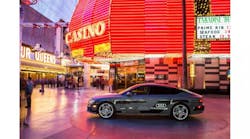Last month, Mark Fields – president and CEO of Ford Motor Co. – provided some interesting insight into how the concept of “mobility” is starting to be reworked in the minds of vehicle manufacturers; a reworking that includes (of course) self-driving cars and trucks (also known as autonomous vehicles or AVs).
“We now are moving from experimentation to implementation,” Fields noted during the OEM’s annual trends conference in Palo Alto, CA. “Our goal is to make people’s lives better by helping them more easily navigate through their day, address societal issues and, over time, change the way the world moves.”
Those goals are incorporated into the Ford Smart Mobility program. Unveiled back in January, it revolves around 25 experiments aimed at re-examining global mobility needs. Now, after six months of gathering data and consumer insights, Fields said Ford is now focusing on two strategic areas – flexible use and ownership of vehicles plus “multimodal” urban travel solutions.
OK, so how do those concepts translate into reality? For starters, Ford Motor Credit is rolling out a new pilot program called “Peer-2-Peer Car Sharing” that will involve 14,000 of its customers in six U.S. cities and 12,000 in London renting their vehicle to other pre-screened drivers for short-term use through November.
Ford’s “car sharing” pilot program – which is aimed at offsetting monthly vehicle ownership costs – will function alongside a similar project called GoDrive; an on-demand public car-sharing pilot in London.
That service offers access to a fleet of 50 cars stationed at 20 locations for one-way journeys with guaranteed parking spots, the OEM noted; encompassed under a pay-as-you-go, per-minute pricing plan.OK, so, what has any of this to do with improving transportation networks? Well, Gabe Klein – former director of Chicago’s Department of Transportation – noted in a speech back during the annual “Washington Briefing” held by the American Association of State Highway and Transportation Officials (AASHTO) back in February that AV technology combined with “vehicle sharing” can open up a variety of new mobility opportunities.
“AVs are going to hit the roads much quicker than many people think,” he explained. “And we’re going to be able to do a lot of things with them, especially at the city level, than we’ve able to do with vehicles in the past.”
For example, Klein envisions people being allowed to drive “manually” on highways or rural roads outside of the cities. “Then once you enter a city’s limits, vehicles must enter ‘autonomous’ mode” not only as a way to improve roadway safety but to “free up” occupants to perform other tasks, especially if caught in congestion.
Upon arrival at work, however, instead of parking one’s vehicle, Klein envisions it getting sent off in full-AV mode to provide paid transport service as a taxi, or temporarily entering a car-sharing program – earning functions that allow the vehicle’s owner to make money while they are not using it.
Yet Ford also realizes that, in many cities, commuting via motor vehicles from home to work is simply not feasible. Thus the automaker is developing an electric bike called the “MoDe:Flex” and a prototype smartphone app to make using such “eBikes” easier for urban commuters.
Believe it or not, the “MoDe:Flex” is Ford’s third eBike design – built with a center frame assembly includes the motor and battery, while the front and rear assemblies and wheels can be configured for road, mountain or city riding. The bike can then be folded up and stored inside any Ford vehicle, where it can be charged while stowed as well.
Like the MoDe:Me and MoDe:Pro eBikes introduced in March, this laest eBike also connects to a smart phone app called “MoDe:Link” that does a wide range of things: provide real-time information regarding weather, congestion, parking costs, time, traffic and public transportation; offer eyes-free navigation and route planning; plus identify the most efficient and cost-effective mode of transport for a journey.
Here are a few other “multimodal” projects Ford is working on:
- Dynamic Shuttle: An on-demand ride-sharing service being tested in New York and London studied how shuttle buses – in this case, a Transit van – should be modified to make it most accommodating to consumers. Items desired by riders testing this “dynamic” shuttle include: transparent fares and travel times; amenities such as Wi-Fi; and a less-than-five-minute walk to or from their pick-up and drop-off points.
- The InfoCycle: How can bicycles best be used in urban environments? To figure that out, bikes need to be equipped with data-gathering sensors to: compile information about traffic patterns, pedestrians and road conditions that is difficult to obtain from vehicle sensors; combining that bike-gleaned data with vehicle data to further analyze road quality, characterize micro-climates, or identify traffic patterns. That would allow cities a way to develop better bike lanes while bike riders could get insights on the best routes to use as well as real-time information on areas to avoid.
- Data-Driven Insurance: Imagine creating driver profiles based on actual behind-the-wheel behavior then sharing with insurance providers and rental car companies for more personalized – and potentially more discounted – rates. Insights include. Ford’s experiments so far indicate that such a system works better if drivers see the benefits of improving driving habits and are rewarded for changing behavior.
That’s some pretty neat stuff. It’ll be interesting to see how Ford fine-tunes all of that to make it become concrete reality – if, of course, such concrete reality can be ultimately achieved for such projects.




